Guillermo del Toro explains why his Pinocchio has so much fascism in it
- Oops!Something went wrong.Please try again later.
- Oops!Something went wrong.Please try again later.
First announced in 2008 but long mired in development hell, Guillermo del Toro's version of Pinocchio is finally here. The Oscar-winning director, known for his love of fairy tales and mythology, has created something highly singular from one of the world's most famous fairy tales. In the decades since Italian author Carlo Collodi first published The Adventures of Pinocchio in 1883, the story of a wooden puppet who wants to become a real boy has been told over and over again, in many mediums, with varying success.
Del Toro's Pinocchio is strikingly different from the classic Disney 1940 version (tself remade just this year by director Robert Zemeckis), and his innovations go beyond the expressive use of stop-motion animation. The Mexican director's take is rooted in the real-life history of Italian Fascism between the World Wars, and is, overall, a more downbeat affair.
Now that Guillermo del Toro's Pinocchio is streaming on Netflix, EW caught up with the filmmaker to discuss his lifelong love of the story and how he found a personal way into it.
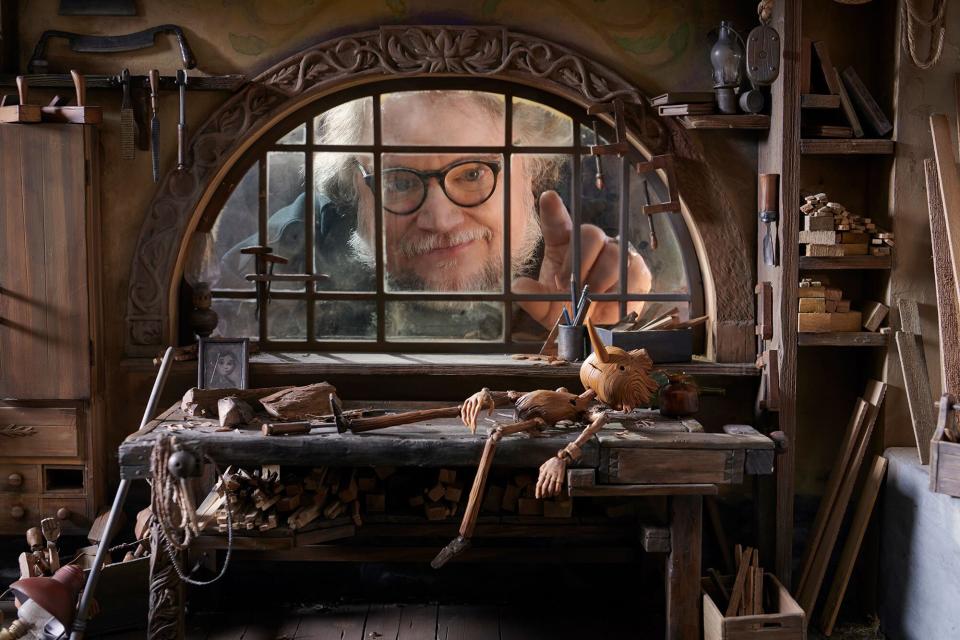
Jason Schmidt/NETFLIX Guillermo del Toro's long-awaited stop-motion 'Pinocchio' film comes to Netflix this December.
ENTERTAINMENT WEEKLY: What was your very first encounter with the Pinocchio story?
GUILLERMO DEL TORO: My father didn't like movies, but my mother loved movies. And she would take me and my brother, sometimes me alone, to see a movie on the weekend. And the second or third movie I saw with her was Pinocchio. And I found it really incredible. It is one of my three favorite Disneys. To this day, I worship it. I think it's a perfect animated movie. But back then what struck me was that it was the first movie I'd seen that captured how scary the world felt to me as a child.
It's so scary!
So scary. And when people talk about this being a darker Pinocchio, I go, "Now, it is dark, but it's not the darkest." I kept thinking about it, and I identified with Pinocchio because I felt a little bit like I didn't completely belong to the world. I was not the kind of child people expected a child in the '60s to be. Like I needed to be outgoing and play football, and instead I was a very quiet, introverted reader. So I identified with Pinocchio, and later when I identified with Frankenstein's monster, I made the connection: Oh, he is the same character in a way. He's created, he doesn't belong. He has to go through the world to learn the ways of men.
When I started making little Super 8s, I told my mom, "I would like to make a Pinocchio." What do you say to a filmmaker that is under 10? "Of course you can." It stayed in my mind. When I was in my 20s, right before doing Cronos, one of the ideas I liked was the idea of doing a Pinocchio in a historical setting that was totalitarian. I was interested in having him go out to war or be recruited as a soldier, things like that. But it was very big and, little by little, as I moved toward other projects and I did The Devil's Backbone, I thought maybe it can take place in Spain or Italy.
If you identified with Pinocchio as a kid, do you now identify with Geppetto as an artist and creator?
Well, the thing that anchored this movie is identifying as a father, because before that I identified as a son. And it's very different. One of the things that happened to me as an adult is that I tried to avoid the things that I thought my father did wrong by doing the opposite, and the results were exactly the same. Meaning one morning I realized I was acting like my dad. That was a big reckoning. I lost my dad five years ago, and I was able to make a lot of peace with the idea of the father figure. But I also see how fathers tend to not listen or not see their kids for what they are, just what they want them to be. So when I wrote this movie with Patrick McHale, I had the perspective of Geppetto and the perspective of Pinocchio. As the Cricket says, very beautifully, "This is a story of imperfect fathers and imperfect sons."
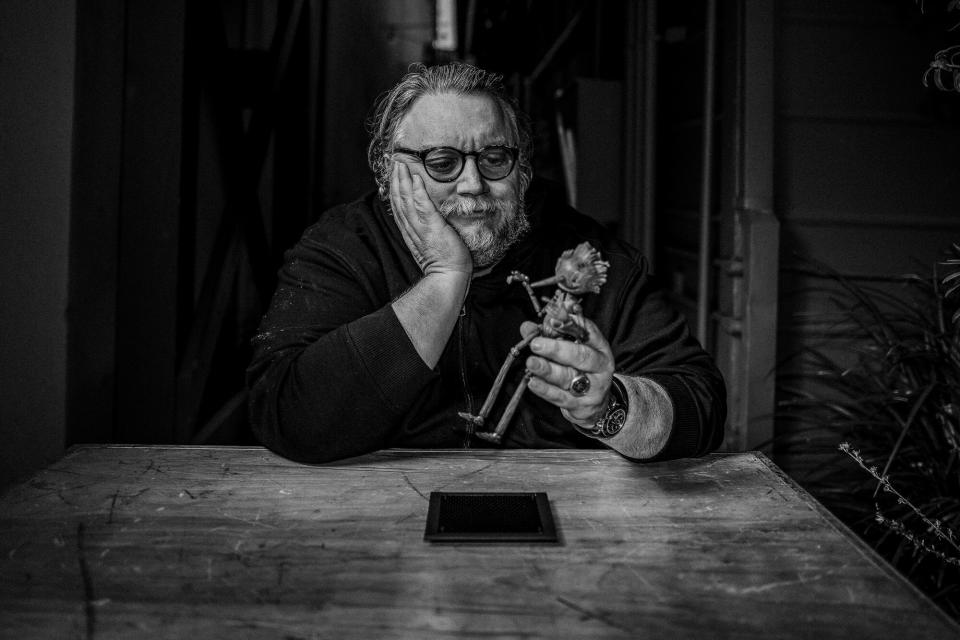
NETFLIX Partners: Guillermo del Toro and Pinocchio.
We mentioned the Disney version already, but Pinocchio is a story that has been told many times in many mediums. With your stop-motion film, what was gained by telling the story of this puppet through actual puppetry?
That was the point of going into stop-motion. Every single Pinocchio movie has to confront the fact that if you don't solve the Pinocchio design, it becomes a reverse of the uncanny valley. He's always going to be popping out as a creepy thing, and you're never going to empathize with him.
So the perfect solution is everybody's a puppet, and the only one that doesn't act like a puppet is the puppet. That serves the theme of disobedience as a virtue, which we embrace rather than the traditional "obedience as a virtue" moral of Pinocchio. That's why the possessive title credit does a lot of the clearing. This is not Walt Disney's Pinocchio, this is not Carlo Collodi's Pinocchio. This is a Pinocchio that belongs next to Pan's Labyrinth and The Devil's Backbone. It's not for kids, but kids can watch it.
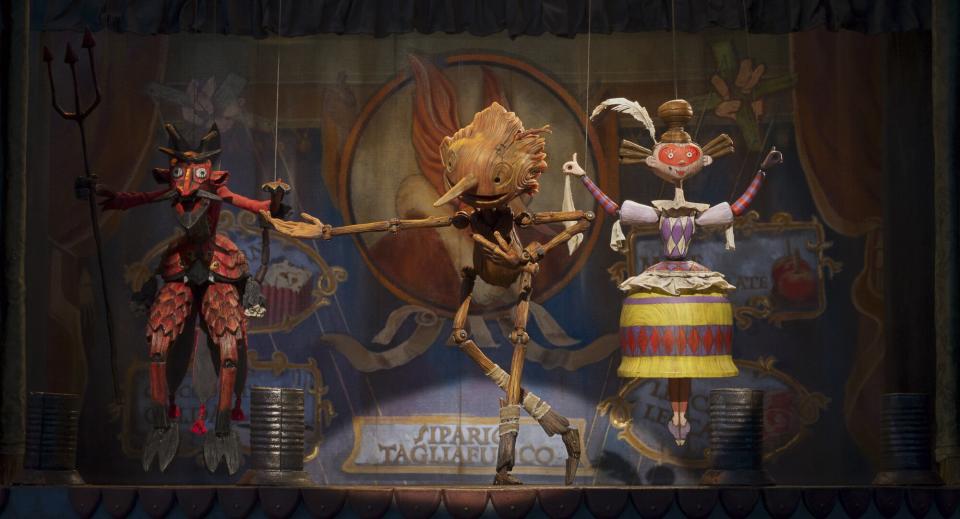
Netflix Puppets dance in 'Guillermo del Toro's Pinocchio.'
Both Pan's Labyrinth and The Devil's Backbone incorporate the Spanish Civil War. You said that from an early stage, you wanted to bring real-life authoritarianism into your Pinocchio story. What do you think it adds? The original Carlo Collodi story is about Pinocchio being taught to conform to society's rules, and it feels like if you stretch that idea beyond a certain point, it can mutate into fascism.
Collodi's tale was very politically loaded. It was serving the needs of Italy at that exact time. It was a foundational idea to try to embrace obedience and to embrace the love of the elders, as they were fusing their society into a republic and creating this sense of pride of country and family and all of that. So its nature is political. Now that is serving the central idea of obedience as a virtue. If we are telling the story of disobedience as a virtue, the best background politically is going to be a totalitarian time. And on top of that, if you are doing stories of fathers and sons — Geppetto and Pinocchio, Spazzatura and Volpe, the fascist officer and his son, Jesus and his father — then the most caustic and corrosive form of paternal figure is the fascist idea of the strong man, Mussolini.
There are five strands of narrative in the screenplay, and you've got to keep all those balls in the air at all times: You have the father-and-son story; you have the death and life and resurrection story; you have the parallels of Pinocchio as a messiah that dies and resurrects and is made of wood and nails and how he comes back to save those that he loves; there is the strand of the war, which happens in the periphery and never quite takes central stage; and finally is the temptation of the pageantry of show business. So all of these things need to be balanced.
And they connect and overlap, right? For example, writers and thinkers in the '20s and '30s pointed out at the time how one of the innovations of fascism was how it brought elements of showbiz and aesthetics into politics.
Yeah. Listen, just the other day somebody said, "Well, that giant M for Mussolini in the reeducation camp looks a little bit cartoony." And I said, "That's actually based on a real photograph." I mean, the pageantry of fascism is very show-business-like in a way. That's why instead of Pleasure Island, where the kids eat candy and play, we have the education camp where they play at war and then instead of turning into donkeys, they are given gas masks. And the father puts a real gun and says, "Shoot your friend." That's the consequence.
It also feels connected with Geppetto's grief over the loss of his son Carlo in World War I. Fascism is one response to World War I, but Geppetto responds differently by trying to re-create his son.
Yeah, but it's a very angry recreation. Instead of the Geppetto that you get in a normal Pinocchio adaptation, where he's a saintly little sweet old man, we wanted to make clear that this guy is very angry. This guy is a drinker. He's impatient. He isn't really concerned with the way people perceive him. And he basically prays for a miracle, gets the miracle and gets grumpy when the miracle is not exactly what he wanted. But he ends up accepting Pinocchio's imperfection. So instead of Pinocchio learning to be a "real boy," we have Geppetto learning to be a real father, which is a really beautiful arc.
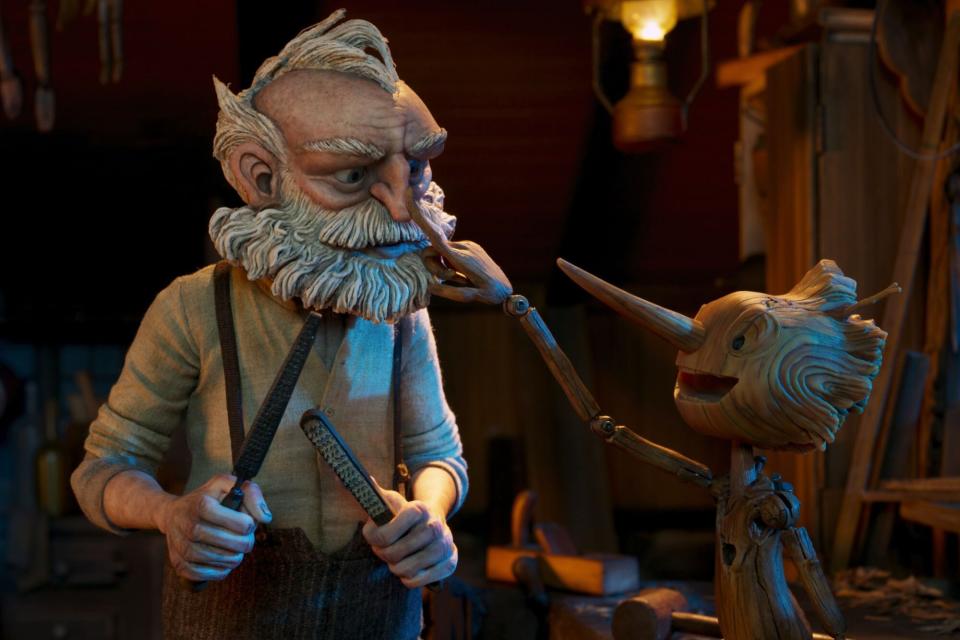
Netflix David Bradley voices Geppetto opposite Gregory Mann's Pinocchio in Guillermo del Toro's 'Pinocchio.'
You mentioned some of the connections between Pinocchio and Frankenstein. They're also both stories about creating life and what it means to be alive. Your approach seems to be that if this is a story about life, then it must also be a story about death. Why did you want to foreground death so much?
In so many fairy tales, somebody has a dialogue with Death or with the devil or with an angel. These are things that I find interesting about them, that you can tackle big subjects. I'm 58, and there is a humility in the realization that you are more than three quarters of the way through your life. I have a quarter left, and that's if I'm lucky. Our time here is important. It is the only time we have to make things better for ourselves and others. The final line of the movie, "What happens, happens, and then we're gone," cannot exist without discussing life and death in the middle. It's a conclusion to that thing.
The central idea of Pinocchio that you give life to something that didn't have it. That is also, by the way, central to the notion of stop-motion animation. So everything is of a piece. That's why it's such a gigantic endeavor collaborating with Patrick McHale on the screenwriting, with Mark Gustafson on the directing, and the best crew of animators.
I was so pleasantly surprised to see Patrick McHale's name in the credits, because I love Over the Garden Wall as I'm sure you do too.
It's a masterpiece.
Yes, I watch it every autumn now. You're talking about fairy tales, it's such a specific wavelength for a story to be on, and Over the Garden Wall nails it. Is that why you wanted to work with him on this?
Well, I think that the sensibility that propelled something like Over the Garden Wall or Pan's Labyrinth is so specific, and it is playing with the Jungian aspects of fairy tales. It's not just somebody that knows the anthropology of fairy tales, but somebody that knows the psychology and the sort of symbolism in there. When I saw Over the Garden Wall, I felt like I had found a twin. So I called him up and I said, "Would you be interested in collaborating on this?" And I pitched him the main ideas on Pinocchio.
The funny thing is that we are compatible on about 80-90 percent of ideas, but the 10-20 percent where we're not compatible is exactly what made it valuable. For example, he didn't like the idea of it being a reincarnation story. He said, "How can we fight that?" Because he shouldn't turn into Carlo, we have to keep Pinocchio Pinocchio. I really love that line I came up with, "the wooden boy with the borrowed soul." I love the idea that Pinocchio is using Carlo's soul, but Pat was like, "It cannot be a reincarnation story because then he has the same son." So these are the things that make collaboration with him great.
That leads us to maybe my favorite moment in the movie, the emotional climax where Pinocchio dies again after the battle with the Dogfish, but he's not resurrecting. Geppetto is asking the Sprite to resurrect him again. And the Sprite's like, "Real boys don't come back." And he's like, "Don't I know that?" I just love what you're saying about finding that perfect balance between Pinocchio and Carlo and Geppetto's emotional relationship to both.
I think ultimately that struggle between Pinocchio being Pinocchio or being Carlo completely pays off in that moment because he's not losing Carlo again.
Then it leads to the thing that made the movie the hardest to finance, which was the ending. The movie ends with what is, for me, a beautiful existential note: "What happens, happens, and then we're gone." But when we met with the studios about this movie, and I would say, "Everybody dies except Pinocchio," everybody was running for the emergency exit. I kept saying, "It can be beautiful." Of course it was the same with Pan's Labyrinth. Whenever I told the story, everybody was interested and fascinated, and then I would say, "The captain shoots the girl." Everybody was like, "No!"
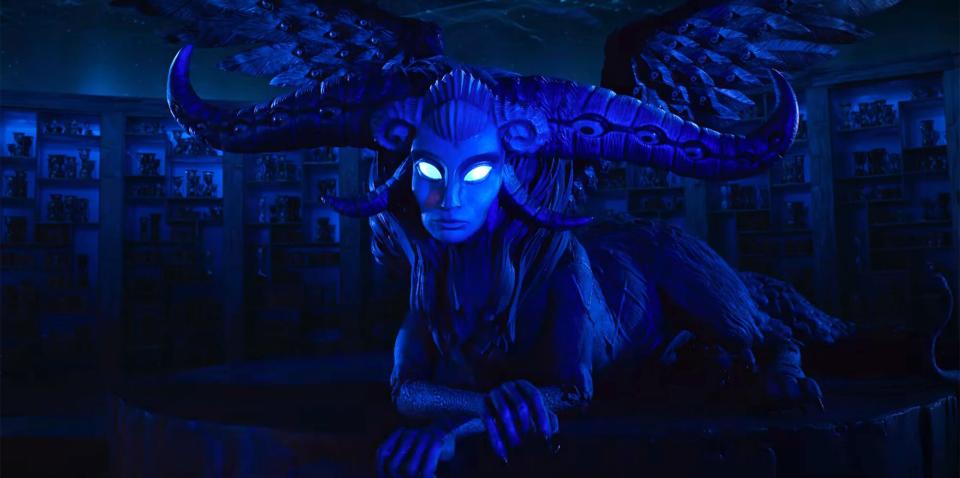
Netflix The Sphinx (Tilda Swinton) in Guillermo del Toro's stop-motion 'Pinocchio' film.
Life and death are embodied in the two fairies that Tilda Swinton plays, representing life and death. How did you think through these designs? They're such intricate chimeras.
Yeah, that's exactly the right word. Chimeras in Mexico are called Alebrijes, and they are the composites of birds, dragons, reptiles and felines. The wings come from Judeo-Christian mythology, which is very much illustrated in colonial Mexican paintings. The configuration of wings is different from a seraphim to an archangel. So the Sprite is very seraphim-like, and then the wings of the Sphinx are more archangel-like, but each of the feathers has an eye that is meant to represent a soul. Guy Davis and I also tried to evoke the Mesopotamian sculptures of winged bulls.
By the end of the design, I said, "When I create entities that are superhuman, I like to erase the face." So the Angel of Death in Hellboy II, or the Pale Man in Pan's Labyrinth, I think it's better that they have no face. And the solution we came up with for this was silver masks. So life and death have sort of the same silver mask and you can only perceive their voice. Then in the animation, we gave them very different body language. The Sphinx is very based on Bela Lugosi, and the other one moves almost like Doug Jones, like a fish with fins. We designed them to be sisters, but very different.
Want more movie news? Sign up for Entertainment Weekly's free newsletter to get the latest trailers, celebrity interviews, film reviews, and more.
Hear more on all of today's must-see picks on EW's What to Watch podcast, hosted by Gerrad Hall.
Related content:

